Text
Homes Where Authors Wrote Books
Greetings! This is Kay F. Davis. I am an editor and writer with a background in the humanities.
I am writing a blog about homes where authors wrote books. While you may think of an "author" as someone who has written a work of literature, an author may be a journalist, an architect, or a professional in a field other than creative writing.
The goal is to present interesting houses, open to the public, that were used to write great books.
First up, a series of homes by architect Frank Lloyd Wright. Enjoy!

Kay F. Davis, Author of Literary Spaces
0 notes
Text
Taliesin
5607 County Road C Spring Green, WI 53588 (608) 588-7900 [email protected] taliesinpreservation.org I visited Taliesin in August 2022 in Spring Green, Wis., hometown of Frank Lloyd Wright. I took a flight to Chicago and an inexpensive Coach USA bus that travels from O'Hare Airport to Janesville, Wis. From there, I took a cab for the 45-minute ride to Spring Green.
Taliesin sits in the middle of a hilly rural region. The visitor center overlooks a river that divides two counties.
A bus took my tour group from the visitor center to the outbuildings and home. The tour is of the third version of the home.

Taliesin tour bus at visitor center Frank Lloyd Wright began work on An Autobiography here in 1925. His wife, Olgivanna Hinzenberg Wright, encouraged him to put his thoughts on paper. Wright stated, "But for her this book were never written."
Wright began work on the book in 1925. The book was expanded in 1943. Olgivanna was an editor and proofreader of his work.
Kyle Dockery, collections manager, stated that Wright most likely wrote his drafts by hand in his drafting studio at Taliesin III. Either Olgivanna or his secretary, Gene Masselink, typed his documents after he wrote them.
Dockery says that Wright had a desk in his bedroom at Taliesin III. "He was a prolific napper," he says. Wright often woke up in the middle of the night with an idea. He wrote it down in his bedroom.

View from the top of the hill Wright commented about his happy, busy days working at home: "Taliesin life at this time, not too late, is one continuous round of movement, usually in happy rhythms ending in sound sleep for all…only to begin again with play and laughter at sunrise, settling down after breakfast into serious work that is play too -- for we love the work we do, even when we are all adding tired to tired and adding it again."
He also valued education. "All this family was imbued with the idea of education as salvation," he stated. "Education it was that made man out of the brute and saved him from the beast. Education it was…that unlocked the stores of beauty to let it come crowding in on every side at every gate."
Wright made sure that his children received a good education. He valued music and ensured that each learned a musical instrument. He sent his female and male children to colleges and universities.

Taliesin today
Wright found truth sacred. His family motto was "Truth Against the World." On a plaque at his Oak Park home, he wrote, "Truth Is Life."
"I know that recounting facts does not constitute truth," he wrote. "Truth lies deeper. It is something we can feel but seldom touch with facts. So I am better off to have got the facts on record."
Wright notes in An Autobiography that he continued his work on the manuscript when he rented a cabin near Minneapolis. Olgivanna went with him. He wrote by hand and gave his notes to a typist named Maud Devine.
In the 40s and 50s, Wright's apprentices edited his work. Wright's pamphlets and brochures were printed at Taliesin III. A set of murders took place on the grounds. Wright gave some clues about the case in An Autobiography. John Vogelsang worked with Wright on Midway Gardens. He recommended Julian Carlton, the supposed murderer, to Wright and said he was "an ideal servant."
Wright had a disagreement with Vogelsang in Chicago while they were working on Midway Gardens. Wright stated, "Money troubles now. Anxiety. Anger. But still hopes and active promises aplenty." He was in this frame of mind when the murders occurred.
Is there a possibility that Wright had an anger problem? We know from Death in a Prairie House that his mother did. She was accused of beating a child on the back with a rubber mallet. We know that she was unhappy with Wright over his marriage to Catherine Tobin. Throughout his life, Wright seemed to have problems separating from his paramours without conflict.

Another view He stayed, alone, after the murders, at Taliesin. He had one person standing guard with a rifle while he stayed there. He said the sky was black and there was no spiritual presence of the deceased. Mamah Cheney was "utterly gone." Perhaps he was trying to extract her, like a spirit, from the home.
Wright and his son John buried her in an unmarked grave at his family cemetery. He was buried there, instead of at Taliesin West, next to Mamah Cheney's grave. Olgivanna's daughter had him exhumed and buried in Taliesin West.
Miriam Noel was Wright's next paramour. She had written to Wright as a fan. He had burned all of the letters sent to him, unread, about Mamah Cheney's murder. He accepted Noel's letter and agreed to meet with her in person.
Their affair lasted several months. Then, like the Mamah Cheney affair, trouble occurred. In this case, Miriam Noel was high-strung and often emotionally disturbed. She was difficult to get along with. He eventually separated from her.
A second fire occurred at Taliesin thereafter. The "living half of Taliesin" always burned, he recalled. The work half or studio remained each time. This was an indication that no matter how fiery his personal relationships, his professional ones remained intact.
Miriam Noel died in a sanitorium after being in a coma several months. Wright called to make sure she was deceased. He said in his book that she was insane. By then, he had remarried and was with Olgivanna.
Olgivanna Lloyd Wright was also an author. She had a newspaper column in the Capital Times, Madison, Wis. She wrote at Taliesin III and did not have an office at the newspaper. She obtained this job because the editor was their friend. The publisher was an advocate of Wright's work on Madison's Monona Terrace.
Olgivanna most likely wrote her books at Taliesin West in Arizona. She has an autobiography that is very different from Wright's. It was posthumously published.
Taliesin remains a great source to learn about Frank Lloyd Wright, southern Wisconsin, and Usonian architecture. Tours are offered of the estate, house, and landscape. Prices range from $25 to $93. Hours are 8:30 a.m. to 5:30 p.m. daily. See Tours for details.
Sources
Drennan, William R. Death in a Prairie House: Frank Lloyd Wright and the Taliesin Murders. Madison, Wis.: University of Wisconsin Press, 2007.
Wright, Frank Lloyd. An Autobiography. Petaluma, Calif.: Pomegranate Communications, 1943.
0 notes
Text
Frank Lloyd Wright Home and Studio
951 W. Chicago Ave. Oak Park, IL 60302 (312) 994-4000 [email protected] flwright.org In August 2020, I visited Oak Park in Chicago’s West Side. The neighborhood is known for its Frank Lloyd Wright architecture.
Wright, a native of Spring Green, Wis., and a Chicago architect, designed more than 400 homes and public buildings throughout the United States during the first half of the twentieth century.
Wright is known for his residential structures, which feature low roofs, open floor plans, and furnishings to match the home designs. His public building designs echo the natural landscapes surrounding them.
To prepare for the trip, I purchased a book on Amazon called Hometown Architect by Patrick F. Cannon. I learned from Cannon's book that Wright designed twenty-three residences and three civic structures in Oak Park. He designed five residences and two civic structures in nearby River Forest.
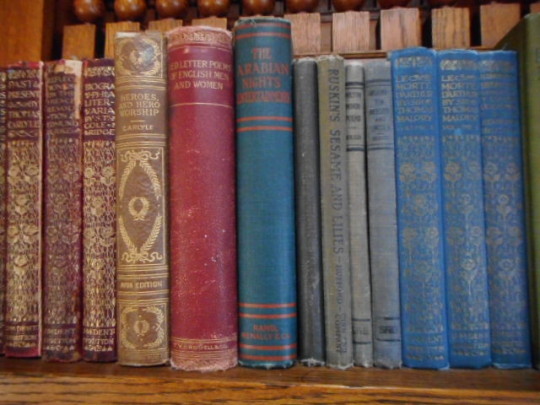
Some of Wright's favorite books, on shelves above the children's playroom of his home The Frank Lloyd Wright Home and Studio was built in 1889 in the Shingle Style. The museum was giving tours during COVID-19. I was able to obtain a museum map from the studio’s gift shop to take on a walking tour after exploring the museum.
As Wright noted in An Autobiography, Oak Park was called “Saint’s Rest.” The community of families and church workers made his mother feel at home. “The quiet village looked much like Madison to mother,” he wrote.
Wright's father, a former preacher, taught at a conservatory in Madison. After a brief sojourn in New England, Wright lived and worked on the farm of his uncle and aunt. He escaped to Chicago and began to apprentice as an architect. Wright's mother moved from Madison to be closer to her son.
Wright reflected on the Queen Anne architecture in the neighborhood while taking a walk one day. The homes, built on tiny lawns, featured a masonry foundation, wood walls with shingles or siding, decorative brackets, bay windows, and gabled roofs. "Simplicity," Wright wrote, "was as far from this scrap-pile as the pandemonium of the barnyard is far from music. But easy enough for the architect."
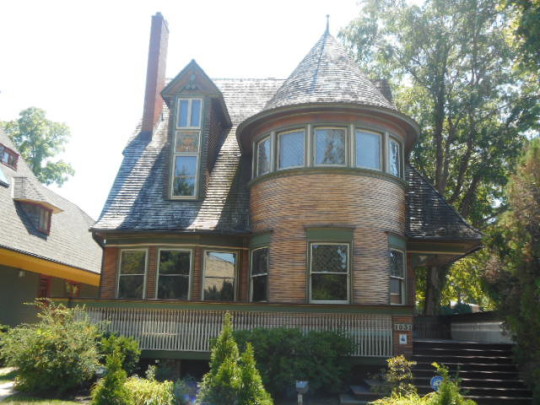
Walter H. Gale House -- Wright's version of the Queen Anne style, before his Prairie School architecture Wright stated, "I had an idea that the horizontal planes in buildings, those planes parallel to the earth, identify themselves with the ground -- make the building belong to the ground. I began putting this idea to work."
Wright's homes were designed with low ceilings to fit someone about 5'8" -- the size of Frank Lloyd Wright. Instead of rooms side by side, he designed a large room with a central fireplace, and dining, kitchen, and sleeping areas around it. Wright made furniture and decorative objects for his homes with the overall design aesthetic of "organic simplicity."
Unlike Louis Sullivan, his former boss, who believed that "form follows function," Wright believed that "form and function are one." Buildings, he wrote, favored "the expressive flow of continuous surface."
Wright had a studio in the home and worked from there until 1895. He converted it into bedrooms in 1895 to accommodate his six children by Catherine Tobin Wright.
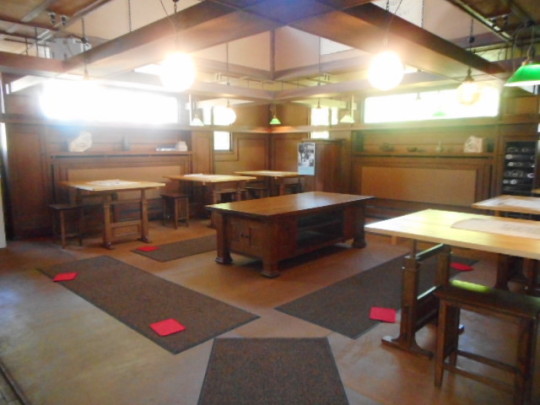
Drafting room Wright built a new studio in 1898, located down the hall from his living quarters. He paid for the studio with money made from designing glass for the American Luxfor Prism Company.
Wright chose an octagonal shape for his studio. The wing featured a drafting room, office, and library. The studio had a waiting area with a desk. Clients could view Wright's plans in the waiting area without entering the drafting room and disturbing the workers.

Waiting room According to Briar Owens, museum manager, Wright sold his studio and did not return to it after the sale. The books he published in later years were written from Taliesin, a home he designed in Spring Green.
Wright moved to Taliesin in 1911. He converted his studio, again, into living quarters. The dwelling was further divided into apartment units during World War II.
During his studio days, he wrote his articles, "A Home in a Prairie Town" and "A Fireproof House for $5,000" and published them in Ladies Home Journal.
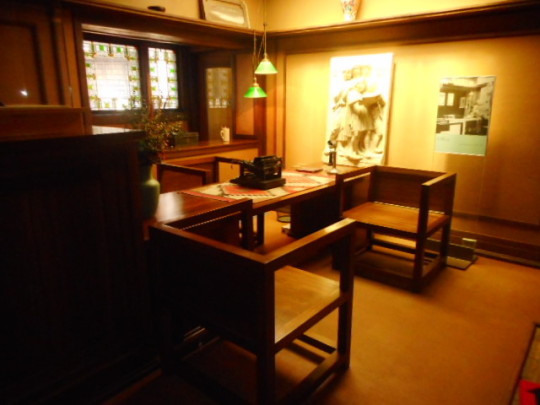
Studio office On a walking tour of the neighborhood, I took pictures of several Wright houses.
Included on the tour is the Prairie Style home of Willam H. Copeland House. Copeland's son-in-law, Walter Pratt Beachy, was a business partner with John Wright, Frank's son, in the company that made Lincoln Logs.
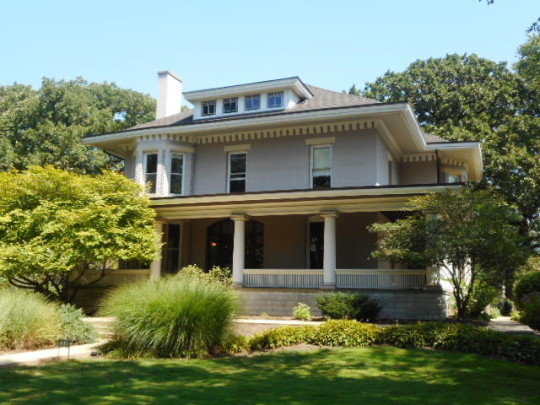
William H. Copeland House Notable is the brick archway over the front entrance of the Arthur B. Heurtley House. Frank Lloyd Wright's sister, Jane Porter, bought the home from Wright's clients and lived there from 1920 to 1946.

Arthur B. Huertley House I returned with a driver in an SUV another day. I asked him to drive me through the neighborhood to look at more of the homes.
At 520 N. East Ave., in a dark walled compound, an author named Mamah Cheney lived with her husband Edwin, a Chicago engineer, and their two children. Wright and Cheney had an affair toward the end of his marriage to Catherine. So the story goes, they used to ride around Oak Park in Wright's yellow sports car.
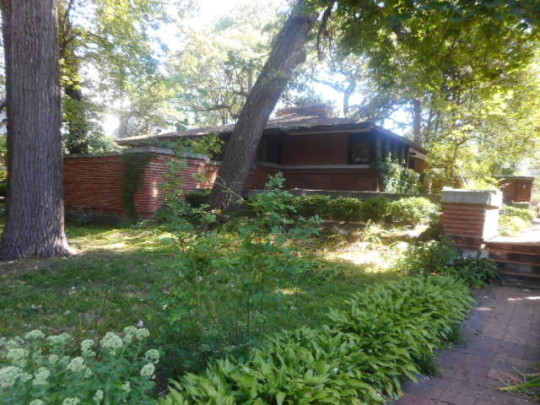
Mamah Cheney House Cheney lived with Wright at Taliesin until a tragedy happened on August 15, 1914. Julian Carlton, a disgruntled worker, murdered Mamah Cheney, her two children, and four of Wright's workers, with a hatchet and burned them.
Wright and Edwin Cheney were in Chicago at the time. While there was an aura of suspicion around them, Carlton was blamed for the crime. He was arrested and died in jail. To get an idea of the public apathy at the time for Carlton, his corpse was dismembered and incinerated after his death.
Wright escaped to Japan before World War II and spent extended periods of time in Russia as well. These sojourns seemed to prevent him from gaining further public scrutiny regarding the murder case.

A sign to recruit volunteers for the museum
The Frank Lloyd Wright Home and Studio was renovated in 1974. It is open to the public for tours. Hours are daily from 10 a.m. to 4 p.m. Tours are $20 to view the home inside and $30 to tour the inside and outside of the home. Book online at flwright.org/tour.
Sources
Cannon, Patrick F. Hometown Architect: The Complete Buildings of Frank Lloyd Wright in Oak Park and River Forest, Illinois. Petaluma, Calif.: Pomegranate Communications, 2006.
Wright, Frank Lloyd. An Autobiography. Petaluma, Calif.: Pomegranate Communications, 1943.
1 note
·
View note